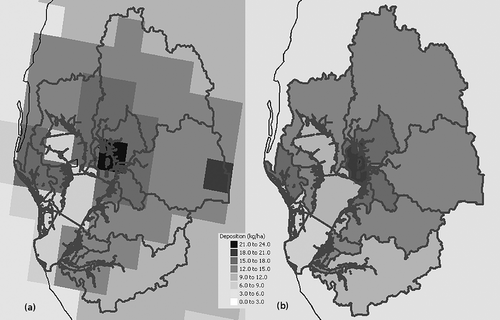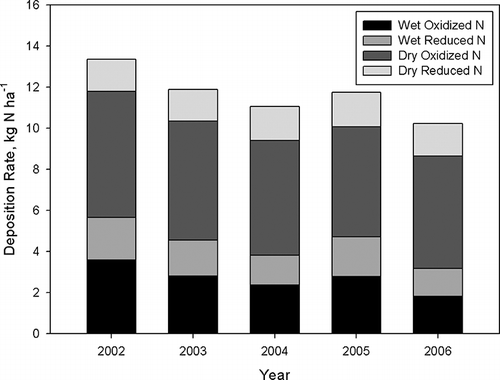Abstract
The U.S. Environmental Protection Agency (EPA) has developed the Watershed Deposition Tool (WDT) to calculate from the Community Multiscale Air Quality (CMAQ) model output the nitrogen, sulfur, and mercury deposition rates to watersheds and their sub-basins. The CMAQ model simulates from first principles the transport, transformation, and removal of atmospheric pollutants. We applied WDT to estimate the atmospheric deposition of reactive nitrogen (N) to Tampa Bay and its watershed. For 2002 and within the boundaries of Tampa Bay's watershed, modeled atmospheric deposition rates averaged 13.3 kg N ha−1 yr−1 and ranged from 6.24 kg N ha−1 yr−1 at the bay's boundary with Gulf of Mexico to 21.4 kg N ha−1 yr−1 near Tampa's urban core, based on a 12-km × 12-km grid cell size. CMAQ-predicted loading rates were 1,080 metric tons N yr−1 to Tampa Bay and 8,280 metric tons N yr−1 to the land portion of its watershed. If we assume a watershed-to-bay transfer rate of 18% for indirect loading, our estimates of the 2002 direct and indirect loading rates to Tampa Bay were 1,080 metric tons N and 1,490 metric tons N, respectively, for an atmospheric loading of 2,570 metric tons N or 71% of the total N loading to Tampa Bay. To evaluate the potential impact of the U.S. EPA Clean Air Interstate Rule (CAIR, replaced with Cross-State Air Pollution Rule), Tier 2 Vehicle and Gasoline Sulfur Rules, Heavy Duty Highway Rule, and Non-Road Diesel Rule, we compared CMAQ outputs between 2020 and 2002 simulations, with only the emissions inventories changed. The CMAQ-projected change in atmospheric loading rates between these emissions inventories was 857 metric tons N to Tampa Bay, or about 24% of the 2002 loading of 3,640 metric tons N to Tampa Bay from all sources.
Air quality modeling reveals that atmospheric deposition of reactive nitrogen (N) contributes a significant fraction to Tampa Bay's total N loading from external sources. Regulatory drivers that lower nitrogen oxide emissions from power plants and motor vehicles are important to bay management strategies, which seek to improve water quality through N load reduction.
Introduction
Tampa Bay is a 100,000-ha subtropical, shallow, tidal estuary on the western coast of central Florida and eastern side of Gulf of Mexico (). Land use in Tampa Bay's 600,000-ha watershed is predominantly urban in its western and northern sectors, agricultural in its southern and eastern sectors, and industrial in ports on the bay's coastline. Fluxes of reactive nitrogen (N) to the bay and recycling of accumulated nutrients within the bay contribute to algal blooms, which shade the water column and create conditions that are unfavorable for sea grasses (CitationConley et al., 2009; CitationGreening et al., 2011; CitationWang et al., 1999). Sea grasses are important to the estuary as a nursery for fish and shellfish and for their ability to retain sediment. In 2002, sea-grass coverage within the bay was ∼11,500 ha, or 75% of the coverage seen in the 1950s (CitationGreening et al., 2011). The bay management strategy seeks to reduce N inputs and to reestablish lost sea-grass beds (CitationGreening and Janicki, 2006).
Figure 1. Tampa Bay and its watershed. Black outlines indicate watershed basin and bay segments boundaries, and darker shading shows municipal boundaries for major cities.

In the mid-1990s, the Tampa Bay Estuary Program and its stakeholders set as a goal reductions in loading of ∼15 metric tons N yr−1 to maintain N loading at levels conducive to sea-grass growth even as the human population grew within the watershed (CitationGreening et al., 2011; CitationGreening and Janicki, 2006). Through management actions, N inputs to Tampa Bay were reduced. In apparent response and concurrent to these reductions, bay water clarity improved, chlorophyll α concentrations decreased, and sea-grass coverage increased (CitationConley et al., 2009; CitationGreening and Janicki, 2006; CitationSherwood, 2011).
New N enters Tampa Bay from nonpoint sources (62%), direct atmospheric deposition (21%), point sources (12%), groundwater discharge (4%), and accidental fertilizer losses (1%) (CitationGreening and Janicki, 2006). Atmospheric N that deposits first to land surface within the watershed and then moves either with stormwater runoff or via groundwater to the bay is referred to as indirect atmospheric deposition and is a nonpoint source. From the preceding percentages, between 21% and 83% of the new N reaching Tampa Bay is from atmospheric N deposition. Reductions of atmospheric contributions to N loading are important to achieving bay water quality goals.
Measurements of atmospheric N deposition near Tampa Bay are scarce. Therefore, air quality modeling is an important source of deposition estimates and for assessments of the change in deposition due to changes in emissions inventories. The Community Multiscale Air Quality (CMAQ) model simulates from first principles the transport, transformation, and removal of atmospheric pollutants (CitationByun and Schere, 2006). The U.S. Environmental Protection Agency (EPA) has developed the Watershed Deposition Tool (WDT) to calculate from the CMAQ model output N, sulfur, and mercury deposition rates to watersheds and their basins (CitationSchwede et al., 2009). , for example, shows WDT's display for annual atmospheric N deposition by basins and bay segments within Tampa Bay's watershed for 2002.
Figure 2. Watershed Deposition Tool (WDT) display for 2002 atmospheric reactive nitrogen (N) deposition by basins and bay segments within Tampa Bay's watershed.
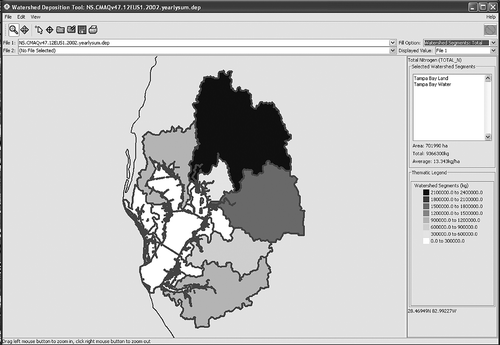
We applied WDT to estimate the atmospheric deposition of N to Tampa Bay and its watershed, to look at temporal trends in N deposition, and to evaluate the aggregate impact to Tampa Bay of the U.S. EPA health-based regulatory drivers associated with the 1990 Clean Air Act Amendments. Monthly CMAQ-modeled wet N deposition rates were compared with wet N deposition rates measured at National Atmospheric Deposition Program (NADP) sites in and near Tampa Bay's watershed.
Experimental Methods
CMAQ modeling
The CMAQ v4.7 chemical transport model simulated horizontal and vertical advection, horizontal and vertical diffusion, gas-phase and aqueous-phase reactions, cloud mixing, aerosol dynamics, size distribution and chemistry, and deposition of gases and aerosols to Earth's surface (CitationByun and Schere, 2006; CitationSchwede et al., 2009). CMAQ v4.7 included revisions to the cloud model, improvements to treatment of secondary organic aerosols and dinitrogen pentoxide (N2O5) parameterization, and added dynamic mass transfer for coarse-mode aerosols, as examples (CitationFoley et al., 2010). Computations for wet deposition included in-cloud scavenging and below-cloud washout of air pollutants based on Henry's Law partitioning for gases and absorption of aerosols into cloud or rain water; dry deposition estimates assumed turbulent transfer of gases and aerosols to the surface and resistance to gas transfer at the surface (CitationByun and Schere 2006; CitationSchwede et al., 2009).
We used CMAQ v4.7 model simulations for 2002–2006 from CitationAppel et al. (2011) that had been postprocessed for the WDT. For these simulations, the modeling domain covered the eastern two-thirds of the United States, southern Canada, and northern Mexico, with a 12-km × 12-km grid cell size and where boundary conditions were provided by a separate 36-km × 36-km continental U.S. simulation (CitationAppel et al., 2011; CitationFoley et al., 2010). Year-specific meteorology was modeled with the Fifth Generation Penn State University/National Center for Atmospheric Research (NCAR) mesoscale model (MM5; CitationGrell et al., 1994). Sparse Matrix Operator Kernel Emission (SMOKE; CitationHouyoux et al., 2000) gridded hourly emissions were built from the EPA 2002 National Emission Inventory (NEI) v3 with year-specific adjustments for emissions from major point sources, mobile sources, and fires. Details of the meteorological modeling, emissions processing, CMAQ inputs, and CMAQ model configuration can be found in CitationAppel et al. (2011). CMAQ-modeled species included reduced N: ammonia (NH3) and ammonium (NH4 +); and oxidized N: nitrogen oxide (NO), nitrogen dioxide (NO2), nitrite (NO2 −), nitrous acid (HNO2), nitrate (NO3 −), nitric acid (HNO3), dinitrogen pentoxide (N2O5), organic nitrate, peroxyacetyl nitrate (PAN), and higher PANs.
Additional files representing 2020 projected emissions based on expected growth and emissions reductions due to the Clean Air Interstate Rule (CAIR, replaced with Cross-State Air Pollution Rule), Tier 2 Vehicle and Gasoline Sulfur Rules, Heavy Duty Highway Rule, and Non-Road Diesel Rule (CitationHouyoux, 2005; CitationU.S. EPA, 2011a; CitationU.S. EPA, 2011b) were used to evaluate the effects on N deposition of proposed air quality regulations. These 2020 CMAQ files were made available by the EPA and were based on the same MM5 meteorology as the 2002 CMAQ runs from CitationAppel et al. (2011) with only the emissions inventories changed.
The Watershed Deposition Tool (WDT)
The EPA has developed the WDT to facilitate the extraction and analysis of CMAQ gridded output data for irregular spatial delineations such as basins and watersheds (CitationSchwede et al., 2009). We downloaded the WDT (CitationU.S. EPA, 2011c) and available CMAQ v4.7 output files (CitationU.S. EPA, 2011d). Watershed basin polygons obtained from the Tampa Bay Estuary Program (TBEP) online technical resources were modified to better define water and land polygons and to achieve a finer spatial resolution (CitationTBEP, 2011). In WDT, CMAQ's grid cells were superimposed over the watershed basins and bay segments as shown in WDT calculates N deposition for each watershed basin or bay segment as the summed product of deposition for each grid cell and the fraction of the overlay area between grid cell and polygon. Average N deposition rates are calculated as basin or bay segment N deposition divided by its area (CitationWiding, 2006).
Nitrogen export from the watershed
Calculation of indirect N loading is challenging, and several approaches for determining N export from watersheds have been used, including (1) a watershed-level mass balance (Castro et al., 2004; CitationGroffman et al., 2004; CitationVan Breemen et al., 2002), (2) land use-specific N export modeling (CitationPoe et al., 2005; CitationWhitall et al., 2003), (3) process-based modeling (CitationPan et al., 2004), and (4) a conserved tracer study (CitationPollman and Poor, 2003). For this analysis, we used the export coefficient of 18% determined by CitationPollman and Poor (2003).
CitationPollman and Poor (2003) used ion ratios obtained from multiyear stream water quality measurements to infer retention and export of atmospheric inputs of N from Tampa Bay's watershed to Tampa Bay, after screening out streams influenced by calcium-rich groundwater or sodium-rich seawater. Chloride was assumed to be a conservative tracer for atmospheric deposition, such that the expected concentration of N ions in stream water was calculated from the product of the observed stream water chloride ion concentration and the ratio of atmospheric N flux to chloride flux. The ratio of observed to expected N ion concentrations in stream water yielded a minimum N retention of 82% or maximum export of 18% for the watershed, which is lower than the estimate of 26% N export for northeastern U.S. watersheds (CitationHowarth et al., 2006) and higher than the estimate of 6% N export for North Carolina's Neuse River Estuary (CitationWhitall et al., 2003).
Wet deposition
Daily rainfall amount and N concentration data were available from a NADP Atmospheric Integrated Research Monitoring Network (AIRMoN) site (CitationNADP, 2012) that was operated by the Environmental Protection Commission of Hillsborough County (EPCHC) from August 1996 to June 2006 in urban Tampa at the eastern end of the Gandy Bridge (FL 18, ) (CitationStrayer et al., 2007). From the Gandy Bridge data, wet deposition rates were calculated according to Equationeq 1, where Crain is the daily rainfall concentration of either NO3 − -N or NH4 + -N and has units of mg L−1, D is the rainfall depth and has units of cm d−1, and Fwet is the deposition rate (i.e., flux) and has units of kg N ha−1 d−1. Daily fluxes were summed to obtain monthly fluxes.
Long-term monthly rainfall amount and N concentration data were available for Verna Wellfield (FL 41), a NADP National Trends Network (NTN) site (CitationNADP, 2011), which is located in Sarasota County and is proximate to the southern boundary of Tampa Bay's watershed (). From the Verna Wellfield data, wet deposition rates were calculated according to Equationeq 1, except that C is the monthly volume-weighted rainfall concentration of either NO3 − -N or NH4 + -N and has units of mg l−1, D has units of cm mo−1, and F is the deposition rate (i.e., flux) and has corresponding units of kg N ha−1 mo−1.
From the simulations of CitationAppel et al. (2011), we obtained CMAQ-modeled precipitation amounts and HNO3, NO3 −, NH3, and NH4 + wet N deposition rates, as well as oxidized N and reduced N wet deposition rates, for the 12-km × 12-km grid cells that enclosed NADP's Gandy Bridge (FL 18) and Verna Wellfield (FL 41) sites. Pearson correlation coefficient (r), normalized mean bias (NMB, Equationeq 2), normalized mean error (NME, Equationeq 3), and root mean squared error (RMSE, Equationeq 4) were computed and plots prepared to assess agreement between modeled and observed wet N deposition rates (CitationEder and Yu, 2006).
where n is the number of observations.
Dry deposition
Measurements of ambient air HNO3, NO3 −, NH3, and NH4 + concentrations were collocated with wet deposition monitoring at FL 18 () from August 1996 to April 2003, sponsored in the latter years by the Bay Region Atmospheric Chemistry Experiment (BRACE) (CitationPoor et al., 2006). Twenty-four-hour integrated samples were collected on a 1-in-6-day schedule with duplicate annular denuder systems (CitationPoor et al., 2006). For the same time period, subhourly measurements of water temperature and wind speed, wind direction, air temperature, and relative humidity were available from a midbay weather station, which was one of the Tampa Bay Physical Oceanographic Real-Time System sites (PORTS t03010) (CitationSopkin et al., 2007). These measurements were used in an integrated National Oceanic and Atmospheric Administration (NOAA) buoy gas deposition and Williams's particle deposition model (CitationEvans et al., 2004; CitationValigura, 1995; CitationWilliams, 1982). Deposition rates were calculated according to Equationeq 5, where Cair is the monthly average N concentration ( μg N m−3), v is the monthly average deposition velocity (m s−1), t is the number of days in a month, and Fdry is the dry deposition flux (kg N ha−1 mo−1) and represents the dry N deposition rate directly to Tampa Bay. NH3 deposition rates were corrected for a bidirectional flux at the bay surface (CitationPoor et al., 2001).
Dry deposition rates so obtained for January 2002 to April 2003 were presented as annual averages to compare with CMAQ-modeled dry deposition rates for the grid cell that enclosed the midbay meteorological tower. This comparison serves as a springboard for discussion of the sources of uncertainty in dry deposition rates.
Nitrogen loading rates
The spatial resolution of watershed basin polygons imported into the WDT allowed us to calculate separately from CMAQ model output the N deposition to land and water (). For direct N loading to Tampa Bay, we integrated the bay segment-specific loading rates; for indirect N loading, we integrated basin-specific rates and assumed that 18% of atmospherically deposited N was transferred from land to bay (CitationPollman and Poor, 2003). Atmospheric loading rates were calculated separately for dry- and wet-deposited N and for oxidized and reduced N.
Table 1. Estimated 2002 direct and indirect atmospheric N loading rates within Tampa Bay's watershed. Water area includes embayment, canals, and major tributaries apportioned by bay segment; land area includes watershed drainage surface by bay segment
Atmospheric N loading to Tampa Bay (LRAD ) was computed as the summed contributions from direct N deposition to the bay surface and indirect N deposition to the land surface of the watershed, where indirect deposition was modified by the fraction of N exported from land to bay or export coefficient (EC), as shown in Equationeq 6, where F has units of kg N ha−1 yr−1, Area has units of ha, and LRAD has units of metric tons N yr−1:
We compared N loading from atmospheric deposition with total N loading to Tampa Bay (). For 2002–2006, CitationPoe et al. (2005) and JEI (2008) estimated total N loading to Tampa Bay from direct atmospheric deposition, nonpoint sources, domestic and industrial point sources, springs, groundwater, and material losses. They calculated direct atmospheric deposition from monthly bay segment-specific rainfall rates, rainfall N concentrations, and seasonal dry:wet deposition ratios. Monthly rainfall N concentrations and seasonal dry:wet deposition ratios came from measurements made at an atmospheric deposition site at the eastern end of the Gandy Bridge (). Contributions from all other source categories were based in general on basin- or bay segment-specific measurements of stream, spring, and groundwater or wastewater discharges and their respective N concentrations; for sub-basins without either stream flow gauges or water quality measurements, an empirical model was applied to determine water discharge rates and N concentrations from monthly rainfall amount and seasonal runoff coefficients based on land use and soil type. CitationTBNMC (2010) revised the point source and materials handling N loading rates used by CitationPoe et al. (2005) and JEI (2008); their updated total and direct N atmospheric deposition rates are given in .
Table 2. Modeled atmospheric deposition (AD) and total N loading to Tampa Bay, 2002–2006
Uncertainty in atmospheric N loading rates
To get an approximation of the combined uncertainty on LRAD , we applied a spreadsheet technique as described by CitationKragten (1994). We assumed that the standard deviation for each of deposition rates in Equationeq 6 was equal to the estimate of the loading rate and that the standard deviation for the export coefficient in Equationeq 6 was equal to the estimate of the export coefficient. These assumptions were not unreasonable based on the RMSE values given in and for wet N deposition rates, comparisons of predicted dry S deposition rates for 15 watersheds reported by CitationMitchell et al. (2011), and the range of watershed N export rates across 43 watersheds studied by CitationCastro et al. (2003). Uncertainties on land and water areas were assumed to be ∼0, and areas and the unit conversion were multiplied through Equationeq 6 such that units on deposition rates were metric tons N yr−1.
Table 3. Statistics to assess agreement between modeled versus observed monthly rainfall and wet N deposition rates for observations made at NADP's Gandy Bridge site (FL18) for 2002 to 2006. Units are cm on mean modeled, mean observed, and RMSE precipitation; units are kg N ha−1 mo−1 on mean modeled, mean observed, and RMSE deposition rates
Table 4. Statistics to assess agreement between modeled versus observed monthly rainfall and wet N deposition rates for observations made at NADP's Verna Wellfield site (FL41) for 2002 to 2006. Units are cm on mean modeled, mean observed, and RMSE precipitation; units are kg N ha−1 mo−1 on mean modeled, mean observed, and RMSE deposition rates
Results and Discussion
Nitrogen loading to Tampa Bay and its watershed
For 2002, the CMAQ model yielded loading rates of 1,080 metric tons N yr−1 to Tampa Bay and 8,280 metric tons N yr−1 to the land portion of its watershed. If we assume a watershed-to-bay transfer rate of 18% (CitationPoor and Pollman, 2003), atmospheric direct and indirect loading rates to Tampa Bay were 1,080 metric tons N yr−1 and 1,490 metric tons N yr−1, respectively, or an atmospheric loading rate to the bay of 2,570 metric tons N yr−1. shows N loading rates by bay segment.
CitationPoe et al. (2005) estimated direct atmospheric and total loading rates for 2002 to Tampa Bay of 840 metric tons N and 3,400 metric tons N, respectively. To determine the relative fraction of CMAQ-modeled atmospheric loading to total loading, we first adjusted the 2002 total N loading rate from CitationPoe et al. (2005) for the CMAQ-modeled direct atmospheric N loading rate (3,400 – 840 + 1,080 = 3,640 metric tons) and second computed the fraction of atmospheric to total loading rates (2,570 metric tons N/3,640 metric tons N), which was 71% and a significant fraction of Tampa Bay's total N loading rate. JEI (2008) estimated direct atmospheric and total N loading rates to Tampa Bay for 2003 through 2006 (). Using the approach just described, we calculated from the CMAQ-model output the direct and indirect atmospheric N loading and fraction of total N loading that is atmospheric for 2003 through 2006 (). Atmospheric loading rates ranged from 1,950 to 2,260 metric tons N yr−1, with significant fractional contributions that ranged from 35% to 63%. In 2003 and 2004, higher rainfall rates increased the hydrological loading within Tampa Bay's watershed, which increased N loading from nonpoint sources and in 2004 led to emergency and accidental discharges of N from industrial point sources.
Contemporary published values for atmospheric loading rates to Tampa Bay vary from 1,100 metric tons N yr−1 to 3,030 metric tons N yr−1; the broad range in estimates suggests significant differences in measurement techniques, computational tools, and methodical assumptions (Poor et al., in review).
The WDT's graphical results for atmospheric N deposition rates are shown , , and For 2002, the CMAQ-modeled average atmospheric deposition rate across the bay and its watershed was 13.3 kg N ha−1 yr−1. Based on the 12-km × 12-km grid cell size, deposition rates ranged from 6.24 kg N ha−1 yr−1 to 21.4 kg N ha−1 yr−1, with the lowest rates predicted over the Gulf of Mexico and highest rates centered on Tampa's urban core, which reflected emissions from the underlying human settlements (). These N deposition rates are characteristic of an estuary and watershed with moderate N pollution (CitationDentener et al., 2006; CitationHolland et al., 2005) Predictions with GEOS-Chem global chemical transport model at a horizontal resolution of 1/2˚ × 2/3 ˚ (∼56 km × 65 km) for west central Florida were in range of ∼8–10 kg N ha−1 yr−1 (CitationZhang et al., 2012), which illustrates the potential impact of grid cell size on modeled N deposition rates.
Figure 4. Atmospheric average (a) dry and (b) wet N deposition rates (kg N ha−1) for Tampa Bay and its watershed, by watershed basin and bay segment, from 2002 CMAQ model simulations.
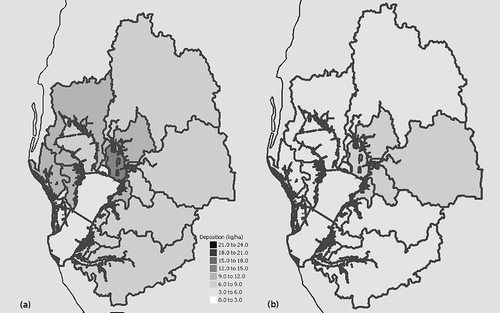
Figure 5. Atmospheric average (a) oxidized and (b) reduced N deposition rates (kg N ha−1) for Tampa Bay and its watershed, by watershed basin and bay segment, from 2002 CMAQ model simulations.
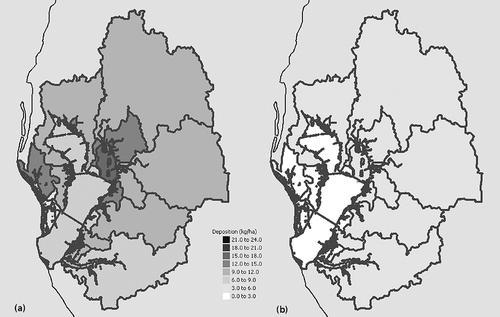
For dry- and wet-deposited N, the 2002 modeled average atmospheric deposition rates were 7.70 kg N ha−1 yr−1 and 5.64 kg N ha−1 yr−1, respectively (). Over land, the dry and wet loading rates were 4,800 metric tons N yr−1 and 3,490 metric tons N yr−1, respectively; over water, the dry and wet loading rates were 608 metric tons N yr−1 and 474 metric tons N yr−1, respectively. Assuming an 18% transfer rate of N from land to water, atmospheric loading rates to Tampa Bay were 1,470 metric tons (57%) dry N and 1,100 metric tons (43%) wet N deposition. Dry N deposition rates were higher in sectors with major traffic corridors and power generation plants near Tampa Bay. For a topographical map of major roadways and industrial and power plant sources near Tampa Bay, refer to CitationPancras et al. (2006) and CitationPark et al. (2005). Modeled spatial gradients of dry N deposition were steeper than corresponding wet deposition N gradients () due to the localized influence of sources or source regions on ambient air concentrations of N at the watershed's surface. Wet N deposition was higher east of the bay over a region of industrial NH3 emissions ().
For oxidized and reduced N, the 2002 modeled average atmospheric deposition rates were 9.73 kg N ha−1 yr−1 and 3.61 kg N ha−1 yr−1, respectively (). Over land, the oxidized and reduced loading rates were 5,990 metric tons N yr−1 and 2,300 metric tons N yr−1, respectively; over water, the oxidized and reduced loading rates were 842 metric tons N yr−1 and 240 metric tons N yr−1, respectively. Assuming an 18% transfer rate of N from land to water, atmospheric loading rates to Tampa Bay were 1,920 metric tons (75%) oxidized N and 650 metric tons (25%) reduced N. The highest rates of oxidized N deposition were associated with urban centers ().
CMAQ-modeled temporal trends in N deposition
Between 2005 and 2010, Florida's annual and ozone season oxidized N emissions from power plants had dropped by 0.11 million metric tons (63%) and 0.054 million metric tons (65%), respectively (U.S. EPA, 2011b), and continued a decade-long downward trend in both power-plant NOx emissions and NOx concentrations measured at urban monitors near Tampa Bay (Poor et al., in review). The observed downward trend in atmospheric NOx concentrations may have important consequences for N deposition to Tampa Bay. According to CMAQ modeling results, dry N deposition dominates both spatial and temporal N deposition rates within Tampa Bay and its watershed. These results suggest that within a watershed monitoring dry N deposition may be as important as monitoring wet N deposition.
By comparison, between 2002 and 2006 the CMAQ-modeled annual average N deposition rates to Tampa Bay and its watershed suggested a modest decline of 3.10 kg N ha−1 yr−1. Of this decline, 0.66 kg N ha−1 yr−1 was from dry deposition of oxidized N, 0.70 kg N ha−1 yr−1 from wet deposition of reduced N, and 1.77 kg N ha−1 yr−1 from wet deposition of oxidized N; dry deposition of reduced N increased by 0.03 kg N ha−1 yr−1 ().
We investigated whether a decline in wet N deposition could be discerned at NADP's Gandy Bridge (FL 18) or Verna Wellfield (FL 41) sites (). For the Gandy Bridge site, we applied an unpaired, two-sided Student's t-test to test the hypothesis that between the first 27 mo and the second 27 mo of the 4.5-yr period the means of log-transformed monthly NO3 −-N or NH4 +-N deposition rates were equal. This hypothesis was not rejected for either NO3 −-N or NH4 +-N deposition rates (p = 0.72 and p = 0.43, respectively). For the Verna Wellfield site, we applied an unpaired, two-sided Student's t-test to test the hypothesis that between the first 30 mo and the second 30 mo of the 5-yr period the means of log-transformed monthly NO3 −-N or NH4 +-N deposition rates were equal. This hypothesis was not rejected for either NO3 −-N or NH4 +-N deposition rates (p = 0.67 and p = 0.17, respectively). Our approach was repeated for rainfall rates and for NO3 − or NH4 + concentrations with similar results. Thus, no significant downward trend in N wet deposition was evident either at the Gandy Bridge or at the Verna Wellfield sites. Small changes in N deposition are likely difficult to discern over short time periods and among the large swings in rainfall and thus wet deposition rates ().
Figure 7. CMAQ-modeled 2002–2006 monthly average wet and dry N deposition rates for Tampa Bay and its watershed.
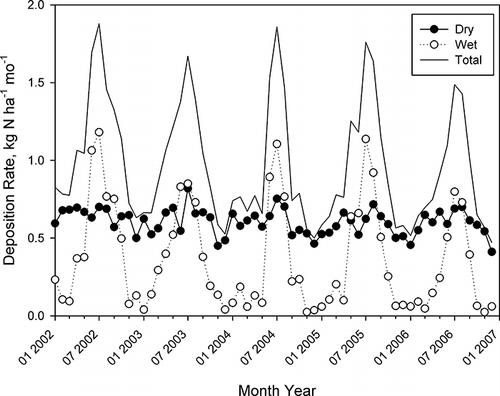
In we show for Tampa Bay and its watershed the temporal variation in modeled monthly dry and wet N deposition rates, which for the 5-yr period shown had means (± standard deviation) of 0.605 (±0.081) and 0.365 (±0.340) kg N ha−1 mo−1, respectively. Given their relatively low coefficient of variation (CV), dry N deposition rates were well predicted by an average value. This was clearly not the case for wet N deposition rates, as temporal gradients were steep with the highest rates seen in midsummer. Dry-to-wet N deposition ratios were 5.99 (±5.17) when averaged over the drier months September through May, and 0.801 (±0.172) when averaged over the wetter months June through August. Annual watershed dry-to-wet N deposition ratios varied from 3.03 in 2002 to 6.48 in 2006 (a dry year) if calculated as the annual average of monthly dry-to-wet ratios, and from 1.36 in 2002 to 2.22 in 2006 if calculated as the average annual dry deposition to annual wet deposition. One can see the challenges in using dry-to-wet N deposition ratios to predict dry N deposition from wet N deposition to the watershed.
Comparison of modeled and observed wet N deposition rates
Wet deposition monitoring at the NADP AIRMoN and NTN stations in and near Tampa Bay's watershed, respectively, offered us an opportunity to assess the agreement between CMAQ modeling and observations of rainfall and wet N deposition rates. Each comparison was of a predicted grid cell average and a point measurement of rainfall amount or N deposition rate, which is by itself a source of error (CitationDavis and Swall, 2006).
Gases of HNO3, HONO, and NH3 are water soluble and are thus scavenged by rainfall. Precipitation acidity in the range of pH 4–5 (CitationStrayer et al., 2007) favors the disassociation of these compounds into NO3 −, NO2 −, and NH4 + in rainfall samples. Water-dissolved NO2 − slowly oxidizes to NO3 − (CitationFinlayson-Pitts and Pitts, 2000) during the collection, transport, and storage of rainfall samples prior to their analysis at NADP's central laboratory. Aerosols containing NO3 − and NH4 + are also removed by rainfall, albeit with differing size-related removal efficiencies (CitationFinlayson-Pitts and Pitts, 2000). Gases of NO and NO2 are poorly water soluble but may interact with an aerosol surface to form HONO; N2O5 readily dissolves in water to form NO3 − and NO2 −(CitationFinlayson-Pitts and Pitts, 2000). Thus, NADP-reported concentrations of NO3 − and NH4 + include both gas and particle contributions.
In CMAQ-modeled wet N deposition, error is present in the emissions inventory, meteorology, and mechanistic representations of atmospheric chemistry and physics. Such errors are discussed by CitationGilliland et al. (2006), who proposed corrections to the NEI for seasonality of NH3 emissions; by CitationDavis and Swall (2006), based on their examination of the effect of MM5’s simulation of precipitation on CMAQ-modeled NH4 + wet deposition; and by CitationChemel et al. (2011) from their investigation of CMAQ's ability to predict a power plant's contribution to N deposition, as examples.
Error is also present in observed wet N deposition rates, so care must be taken not to assign all of the disagreement to modeling. According to CitationWetherbee et al. (2006), for example, “atmospheric wet deposition is slightly underestimated in 48 to 68 percent of the NADP/NTN samples, depending on the analyte.” This underestimate is a consequence of analyte loss during field exposure, sampling handling, and/or shipping. Atmospheric wet deposition is overestimated if the sample is marginally contaminated; gross contamination, however, leads to sample rejection and loss of data, which if uncorrected causes an underestimate in cumulative atmospheric wet deposition.
For the eastern United States, MM5 -simulated precipitation rates were underestimated for synoptic-scale storm systems and overestimated for subgrid-scale convective storm systems (CitationAppel et al., 2011; CitationDavis and Swall, 2006). A similar trend was evident at both NADP's Gandy Bridge (FL 18) and Verna Wellfield (FL 41) sites, where reasonable agreement was seen between modeled and observed rainfall rates for cooler and drier months when rainfall was more likely produced by a synoptic system but a moderate positive bias was seen for summertime (wetter) months when rainfall was more likely generated in convective storms ().
Figure 8. Comparison of CMAQ-modeled and observed precipitation rates for NADP's (a) AIRMoN site at Gandy Bridge (FL18) and (b) NTN site at Verna Wellfield (FL41).
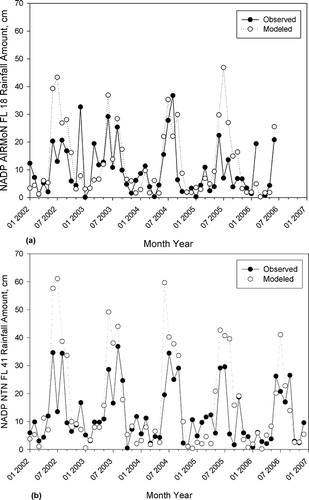
Over a 4.5-yr period at the Gandy Bridge site, the modeled and measured precipitation rates were moderately correlated, with averages of 12.5 cm and 10.0 cm, respectively (); 53% of the modeled monthly rainfall rates were within a factor of 2 of observed rainfall rates. Over a 5-yr period at the Verna Wellfield site, the modeled and measured precipitation rates were moderately correlated, with averages of 16.3 cm and 12.3 cm, respectively (); 62% of the modeled monthly rainfall rates were within a factor of 2 of observed rainfall rates (). Since deposition rates are the product of N concentration and rainfall rate ( Equationeq 1), a bias in rainfall rate will contribute to a bias in N wet deposition.
Figure 9. Scatter plots of CMAQ-modeled and observed (a) precipitation rates, (b) oxidized N wet deposition rates, and (c) reduced N wet deposition rates for NADP's NTN Verna Wellfield (FL41) site.
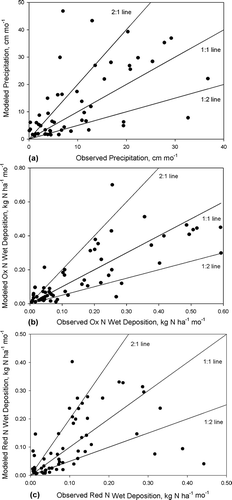
Temporal trends in CMAQ model predictions of precipitation () and atmospheric N deposition () are shown for NADP's Gandy Bridge and Verna Wellfield sites. Rainfall rates were lower but N deposition rates higher at the urban Gandy Bridge site when compared to the rural Verna Wellfield site (). This is a consequence of higher ambient air concentrations of N near the urban core, as is suggested by
Figure 10. Comparison of CMAQ-modeled and observed atmospheric N wet deposition rates for NADP's (a) AIRMoN site at Gandy Bridge (FL18) and (b) NTN site at Verna Wellfield (FL41).
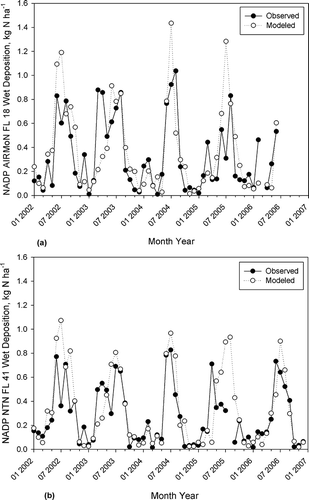
For the Gandy Bridge site, CMAQ model predictions of wet deposition rates were in fair agreement for NO3 − -N and NH4 + -N, with moderate positive bias relative to observations seen for NO3 −-N and a moderate negative bias seen for NH4 + -N (); 59% of the data points for wet deposition rates of both NO3 − -N and NH4 + -N were within a factor of 2, respectively. Thus, CMAQ modeled appeared to overpredict NO3 − concentration and underpredict NH4 + concentration in rainwater for this site.
For the Verna Wellfield site, CMAQ model predictions of wet deposition rates agreed remarkably well for NO3 − -N and NH4 + -N, with a only small positive bias relative to observations (); 75% and 54% of the data points for wet deposition rates of NO3 − -N and NH4 + -N were within a factor of 2, respectively (). For this site, N wet deposition biases were not as large as the precipitation bias, which suggested that errors in precipitation rates were offset by errors in N concentrations; in other words, both NO3 − and NH4 + concentrations were biased low.
CitationAppel et al. (2011) found that for the eastern United States, CMAQ-modeled wet deposition of both NO3 −-N and NH4 +-N were underestimated but that these biases were diminished when model simulations were corrected for lightning-generated NO and bidirectional NH3 exchange. The better model performance for NO3 −-N relative to NH4 +-N wet deposition reflected, perhaps, differences in spatial and temporal resolution of NOx and NH3 emissions inventories (CitationAppel et al., 2011; CitationGilliland et al., 2006) and the lower uncertainty in the NOx emissions compared to NH3 emissions.
Comparison of dry N deposition rates
Eighteen months of direct dry N deposition rates prepared for Tampa Bay as part of the BRACE were compared with the CMAQ model estimates () for a grid cell that enclosed a midbay meteorological station (). The annual average BRACE dry deposition rates were similar to those published by CitationPoor et al. (2001) except for a lower NH4 +-N deposition rate, which reflected an improvement in particle deposition modeling. Note that BRACE estimates had lower HNO3 and higher NO3 −, NH3, and NH4 + N deposition rates when compared to CMAQ-modeled values, although the summed direct dry N deposition rates were within 10% at 3.18 and 2.91 kg N ha−1 yr−1, respectively ().
Table 5. Comparison of annual average CMAQ-modeled and measurement-based direct dry deposition rates to Tampa Bay for 2002–2003
Monthly CMAQ-modeled and BRACE dry N deposition rates were not correlated, nor were they similar in magnitude for individual species. BRACE dry deposition rates were based on N concentrations made over land and assumed to be the same over water, which likely biased estimates high; significant losses of HNO3 and NO3 − at the inlet of the annular denuder system biased estimates low; infrequent sampling attenuated temporal variability and obscured covariance between concentrations and deposition velocities (CitationPoor et al., 2006; CitationPoor et al, 2001). Atmospheric measurements revealed a vertical HNO3 concentration gradient with higher concentrations aloft as a consequence of rapid deposition of HNO3 at the surface (CitationLuke et al., 2007). BRACE concentration measurements were made at a height of 4.2 m asl and CMAQ model concentrations were based on a midpoint of 18 m asl in the lowest model grid cell. Thus, dry N deposition rates may be overestimated if HNO3 concentrations are either measured or modeled well above the surface. CMAQ v4.7 did not include representation of a bidirectional NH3 flux nor the NOx emissions associated with lightning, which may have biased estimates low (CitationFoley et al., 2010). These results highlighted the importance for continued development of robust sensors that are capable of detecting N deposition of gases and particles, not only to monitor temporal and spatial trends of N dry deposition within a watershed but to help establish watershed N budgets and validate air quality model predictions.
Uncertainty in atmospheric N loading rates
summarizes a spreadsheet calculation of combined uncertainty on N loading rates. Given our assumptions on standard deviations of N wet and dry deposition rates and the watershed export coefficient, the overall uncertainty on the 2002 CMAQ-modeled atmospheric loading rate (LRAD ) to Tampa Bay was 2,570 ± 1,990 metric tons N yr−1. The largest and second largest sources of error came from the uncertainty on the N export coefficient and on the estimate of dry N deposition to land, which suggested a need to better understand or to reduce these uncertainties within the Tampa Bay watershed. To address uncertainty in N emissions, CMAQ v5.0 accounts for NOx production from lightning and for bidirectional flux of NH3 at the earth's surface.
Table 6. Spreadsheet calculation of combined uncertainty for atmospheric N loading to Tampa Bay using Equationeq 6, where 
2002 and 2020 N emission scenarios
Through the Clean Air Interstate Rule (CAIR, replaced with Cross-State Air Pollution Rule), Tier 2 Vehicle and Gasoline Sulfur Rules, Heavy Duty Highway Rule, and Non-Road Diesel Rule (U.S. EPA, 2011a, b), U.S. EPA seeks to improve air quality by phased reductions in air pollutant emissions from both fixed and mobile sources. A fully implemented CAIR, for example, removes 6.7 million metric tons of NOx emissions from all states in the continental United States, of which 5.2 million metric tons is from states in the eastern United States (Houyoux, 2005). By 2020, NH3 emissions are expected to grow by 0.44 million metric tons for all states in the continental United States, of which 0.22 million metric tons of NH3 emissions are from states in the eastern United States (Houyoux, 2005). Moreover, slated reductions in sulfur dioxide (SO2) emissions will shift aerosol NH4 + to gaseous NH3 and thus favor localized dry deposition of reduced N (CitationPinder et al., 2008).
For 2002, the CMAQ-modeled direct plus indirect atmospheric loading rate to Tampa Bay was 2,570 metric tons N. Using WDT, we calculated the potential impact of fully implemented CAIR (now Cross-State Air Pollution Rule), Tier 2 Vehicle and Gasoline Sulfur Rules, Heavy Duty Highway Rule, and Non-Road Diesel Rule. Between the 2002 and 2020 emission scenarios, the projected change in atmospheric N loading was 857 metric tons N, which represented 33% less atmospheric loading and 24% less total loading to Tampa Bay for a total loading of 3,640 metric tons N. Such a change if implemented over 18 yr represents a decrease of ∼48 metric tons N yr−1, well above a target reduction rate of 15 metric tons N yr−1 (CitationGreening et al., 2011; CitationGreening and Janicki, 2006). A change in N loading on this order of magnitude bodes well for water clarity goals and expansion of sea grass beds.
Changes in atmospheric N deposition rates across Tampa Bay and its watershed between the 2002 and 2020 emissions scenarios are shown in and revealed a broad decrease of 1 to 2 kg N ha−1 over the entire watershed but as high as 6 to 7 kg N ha−1 in the vicinity of major power plant and industrial sources. Thus, both regional and local emissions controls explain reductions in atmospheric N deposition under the future emissions scenario.
Figure 11. CMAQ-modeled changes in watershed N deposition for 2002 base case and 2020 future scenario emissions for Tampa Bay and its watershed, processed with WDT from CMAQ 2002 12-km gridded scale output: (a) change in gridded N deposition rates (kg N ha−1); (b) change in average N deposition rates by watershed basin and bay segment (kg N ha−1).
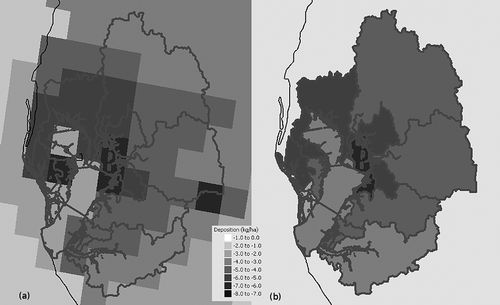
Conclusions
The Water Deposition Tool (WDT) offers a user-friendly interface with CMAQ model output to calculate atmospheric deposition of reactive nitrogen (N) to watersheds and their basins. With WDT we were able to estimate N deposition to both land and bay portions of Tampa Bay's watershed and thereby include direct and indirect atmospheric deposition components. For 2002 and within the boundaries of Tampa Bay's watershed, modeled atmospheric deposition rates averaged 13.3 kg N ha−1 yr−1 and ranged from 6.24 kg N ha−1 yr−1 at the bay's boundary with Gulf of Mexico to 21.4 kg N ha−1 yr−1 near Tampa's urban core, based on a 12-km × 12-km grid cell size. CMAQ-predicted loading rates were 1,080 metric tons N yr−1 to Tampa Bay and 8,280 metric tons N yr−1 to the land portion of its watershed. If we assume a watershed-to-bay transfer rate of 18% for indirect loading, our estimates of the 2002 direct and indirect loading rates to Tampa Bay were 1,080 metric tons N and 1,490 metric tons N, respectively, for an atmospheric loading of 2,570 metric tons N or 71% and a substantial fraction of the total N loading to Tampa Bay.
WDT also opened the door for trend analysis of CMAQ model output. As examples, CMAQ modeling indicated that during an extended dry season, dry N deposition dominated N deposition rates to Tampa Bay and its watershed. Moreover, oxidized N deposition rates greatly exceeded reduced N deposition rates. With WDT we had the opportunity to compare past and future emissions scenarios to assess the impact of emissions controls on N deposition to Tampa Bay and its watershed. To evaluate the potential impact of the U.S. EPA Clean Air Interstate Rule (CAIR, replaced with Cross-State Air Pollution Rule), Tier 2 Vehicle and Gasoline Sulfur Rules, Heavy Duty Highway Rule, and Non-Road Diesel Rule, we compared CMAQ outputs between 2020 and 2002 simulations, with only the emissions inventories changed. CMAQ-projected change in atmospheric loading rates between these emissions inventories was significant at 857 metric tons N to Tampa Bay, or about 24% of the 2002 loading of 3,640 metric tons N to Tampa Bay from all sources.
Acknowledgments
This research was funded by Florida Department of Environmental Protection (FDEP) through the Tampa Bay Estuary Program (TBEP) under FDEP contract AQ206. Noreen Poor is affiliated with the University of South Florida College of Public Health. The U.S. Environmental Protection Agency through its Office of Research and Development collaborated in the research described here. It has been subjected to agency review and approved for publication.
References
- Appel , K.W. , Foley , K.M. , Bash , J.O. , Pinder , R.W. , Dennis , R.L. , Allen , D.J. and Pickering , K. 2011 . A Multi-Resolution Assessment of the Community Multiscale Air Quality (CMAQ) Model v4.7 Wet Deposition Estimates for 2002–2006 . Geoscientific Model Development , 4 : 357 – 371 . doi: 10.5194/gmd-4-357-2011
- Byun , D. and Schere , K.L. 2006 . Review of Governing Equations, Computational Algorithms, and Other Components of the Models-3 Community Multiscale Air Quality (CMAQ) Modeling System . Applied Mechanics Reviews , 59 : 51 – 77 . doi: 10.1115/1.2128636
- Castro , M.S. , Driscoll , C.T. , Jordan , T.E. , Reay , W. G. and Boynton , W. R. 2003 . Sources of Nitrogen to Estuaries in the United States . Estuaries , 26 : 803 – 814 . doi: 10.1007/BF02711991
- Chemel , C. , Sokhi , R.S. , Dore , A.J. , Sutton , P. , Vincent , K.J. , Griffiths , S.J. , Hayman , G.D. , Wright , R.D. , Baggaley , M. , Hallsworth , S. , Prain , H.D. and Fisher , B.E.A. 2011 . Predictions of U.K. Regulated Power Station Contributions To Regional Air Pollution and Deposition: A Model Comparison Exercise . J. Air Waste Manage. Assoc. , 61 : 1236 – 1245 . doi: 10.1080/10473289.2011.609756
- Conley , D.J. , Paerl , H.W. , Howarth , R.W. , Boesch , D.F. , Seitzinger , S.P. , Havens , K.E. , Lancelot , C. and Likens , G. 2009 . Controlling Eutrophication: Nitrogen and Phosphorus . Science , 323 : 1014 – 1015 . doi: 10.1126/science.1167755
- Davis , J.M. and Swall , J.L. 2006 . An Examination of the CMAQ Simulations of the Wet Deposition of Ammonium From a Bayesian Perspective . Atmospheric Environment , 40 : 4562 – 4573 . doi: 10.1016/j.atmosenv.2006.04.007
- Dentener , F. 2006 . Nitrogen and Sulfur Deposition on Regional and Global Scales: A Multimodel Evaluation . Global Biogeochemical Cycles , 20 : GB4003 doi: 10.1029/2005GB002672
- Eder , B. and Yu , S. 2006 . A Performance Evaluation of the 2004 Release of Models-3 CMAQ . Atmospheric Environment , 40 : 4811 – 4824 . doi: 10.1016/j.atmosenv.2005.08.045
- Evans , M.C. , Campbell , S.W. , Bhethanabotla , V. and Poor , N. 2004 . Effect of Sea Salt and Calcium Carbonate Interactions With Nitric Acid on the Direct Dry Deposition of Nitrogen to Tampa Bay, Florida . Atmospheric Environment , 38 : 4847 – 4858 . doi: 10.1016/j.atmosenv.2004.05.046
- Finlayson-Pitts , B.J. and Pitts , J.N. Jr. 2000 . Chemistry of the Upper and Lower Atmosphere , San Diego , CA : Academic Press . doi: 10.1016/B978-012257060-5/50007-1
- Foley , K.M. , Roselle , S.J. , Appel , K.W. , Bhave , P.V. , Pleim , J.E. , Otte , T.L. , Mathur , R. , Sarwar , G. , Young , J.O. , Gilliam , R.C. , Nolte , C.G. , Kelly , J.T. , Gilliland , A.B. and Bash , J.O. 2010 . Incremental Testing of the Community Multiscale Air Quality (CMAQ) Modeling System Version 4.7 . Geoscientific Model Development , 3 : 205 – 226 . doi: 10.5194/gmd-3-205-2010
- Gilliland , A.B. , Appel , K.W. , Pinder , R.W. and Dennis , R.L. 2006 . Seasonal NH3 Emissions for the Continental United States: Inverse Model Estimation and Evaluation . Atmospheric Environment , 40 : 4986 – 4998 . doi: 10.1016/j.atmosenv.2005.12.066
- Greening , H.S. , Cross , L.M. and Sherwood , E.T. 2011 . A Multiscale Approach to Seagrass Recovery in Tampa Bay, Florida . Ecological Restoration , 29 : 82 – 93 . doi: 10.3368/er.29.1-2.82
- Greening , H. and Janicki , A. 2006 . Toward Reversal of Eutrophic Conditions in a Subtropical Estuary: Water Quality and Seagrass Response to Nitrogen Loading Reductions in Tampa Bay, Florida, USA . Environmental Management , 38 : 163 – 178 . doi: 10.1007/s00267-005-0079-4
- Grell , G.A. , Dudhia , J. and Stauffer , D.R. 1994 . A Description of the Fifth Generation Penn State/NCAR Mesoscale Model (MM5) , Boulder , CO : NCAR Tech Note, NCAR/TN-398+STR .
- Groffman , P.M. , Law , N.L. , Belt , K.T. , Band , L.E. and Fisher , G.T. 2004 . Nitrogen Fluxes and Retention in Urban Watershed Ecosystems . Ecosystems , 7 : 393 – 403 . doi: 10.1007/s10021-003-0039-x
- Holland , E.A. , Braswell , B.H. , Sulzman , J. and Lamarque , J.-F. 2005 . Nitrogen Deposition Onto the United States and Western Europe: Synthesis of Observations and Models . Ecological Applications , 15 : 38 – 57 . doi: 10.1890/03-5162
- Houyoux , M.R. , Vukovich , J.M. , Coats , C.J. Jr. , Wheeler , N.J.M. and Kasibhatla , P.S. 2000 . Emission Inventory Development and Processing for the Seasonal Model Or Regional Air Quality (SMRAQ) Project . Journal of Geophysical Research, Atmospheres , 105 ( D7 ) : 9079 – 9090 . doi: 10.1029/1999JD900975
- Houyoux, M. 2005. Clear Air Interstate Rule: Emissions Inventory Technical Support Document, United States Environmental Protection Agency. http://www.epa.gov/cair/technical.html (http://www.epa.gov/cair/technical.html)
- Howarth , R. W. , Swaney , D. P. , Boyer , E. W. , Marino , R. , Jaworski , N. and Goodale , C. 2006 . The Influence of Climate on Average Nitrogen Export From Large Watersheds in Northeastern United States . Biogeochemistry , 79 : 163 – 186 . doi: 10.1007/s10533-006-9010-1
- Janicki Environmental, Inc . 2008 . Estimates of Total Nitrogen, Total Phosphorus, Total Suspended Solids, and Biochemical Oxygen Demand Loadings to Tampa Bay, Florida: 2004–2007 , Tallahassee , FL : Florida Department of Environmental Protection .
- Kragten , J. 1994 . Calculating Standard Deviations and Confidence Intervals With a Universally Applicable Spreadsheet Technique . Analyst , 119 : 2161 – 2165 . doi: 10.1039/an9941902161
- Mitchell , M.J. , Lovett , G. , Bailey , S. , Beall , F. , Burns , D. , Buso , D. , Clair , T.A. , Courchesne , F. , Duchesne , L. , Eimers , C. , Fernandez , I. , Houle , D. , Jeffries , D.S. , Likens , G.E. , Moran , M.D. , Rogers , C. , Schwede , D. , Shanley , J. , Weathers , K. and Vet , R. 2011 . Comparisons of Watershed Sulfur Budgets in Southeast Canada and Northeast US: New Approaches and Implications . Biogeochemistry , 103 : 181 – 207 . doi: 10.1007/s10533-010-9455-0
- Luke , W. T. , Arnold , J. R. , Watson , T. B. , Dasgupta , P. K. , Li , J. , Kronmiller , K. , Hartsell , B. E. , Tamanini , T. , Lopez , C. and King , C. 2007 . The NOAA Twin Otter and Its Role in BRACE: A Comparison of Aircraft and Surface Trace Gas Measurements . Atmospheric Environment , 41 : 4190 – 4209 . doi: 10.1016/j.atmosenv.2006.07.060
- National Atmospheric Deposition Program. 2011. National Atmospheric Deposition Program, National Trends Network http://nadp.sws.uiuc.edu/ntn (http://nadp.sws.uiuc.edu/ntn) (Accessed: 2 November 2011 ).
- National Atmospheric Deposition Program. 2012. National Atmospheric Deposition Program, Atmospheric Integrated Research Monitoring Network http://nadp.sws.uiuc.edu/AIRMoN (http://nadp.sws.uiuc.edu/AIRMoN) (Accessed: 21 July 2012 ).
- Pan , Y. , Hom , J. , Birdsey , R. and McCollough , K. 2004 . Impacts of Rising N Deposition on N Exports From Forests to Surface Waters in the Chesapeake Bay Watershed . Environmental Management , 33 : S120 – S131 . doi: 10.1007/s00267-003-9122-5
- Pancras , J. P. , Ondov , J. M. , Poor , N. , Landis , M. S. and Stevens , R. K. 2006 . Identification of Sources and Estimation of Emission Profiles From Highly Time-Resolved Pollutant Measurements in Tampa, FL . Atmospheric Environment , 40 : S467 – S481 . doi: 10.1016/j.atmosenv.2005.12.036
- Park , S. S. , Pancras , J. P. , Ondov , J. and Poor , N. 2005 . A New Pseudodeterministic Multivariate Receptor Model for Individual Source Apportionment Using Highly Time-Resolved Ambient Concentration Measurements . Journal of Geophysical Research , 110 : D07S15 doi: 10.1029/2004JD004664
- Pinder , R.W. , Gilliland , A.B. and Dennis , R.L. 2008 . Environmental Impact of Atmospheric NH3 Emissions Under Present and Future Conditions in Eastern United States . Geophysical Research Letters , 35 : L12808 doi: 10.1029/2008GL033732
- Poe , A. , Hackett , K. , Janicki , S. , Pribble , R. and Janicki , A. 2005 . Estimates of Total Nitrogen, Total Phosphorus, Total Suspended Solids, and Biochemical Oxygen Demand Loadings to Tampa Bay, Florida: 1999–2003, Final Report, March 2005 , St. Petersburg , FL : Tampa Bay Estuary Program Technical Publication 02-05 .
- Pollman , C. and Poor , N.D. 8–12 December 2003 . Export of Atmospherically Derived Nitrogen in the Tampa Bay Watershed , 8–12 December , San Francisco , CA : Presented at American Geophysical Union (AGU) Fall Meeting .
- Poor , N.D. , Cross , L.M. and Dennis , R.L. “ Lessons Learned from the Bay Region Atmospheric Chemistry Experiment (BRACE) and Implications for Nitrogen Management of Tampa Bay ” . In Atmospheric Environment ATMENV-D-12-00827, in review
- Poor , N. , Pollman , C. , Tate , P. , Begum , M. , Evans , M. and Campbell , S. 2006 . Nature and Magnitude of Atmospheric Fluxes of Total Inorganic Nitrogen and Other Inorganic Species to the Tampa Bay Watershed, FL, USA . Water, Air, and Soil Pollution , 170 : 267 – 283 . doi: 10.1007/s11270-006-3055-6
- Poor , N. , Pribble , R. and Greening , H. 2001 . Direct Wet and Dry Deposition of Ammonia, Nitric Acid, Ammonium, and Nitrate to Tampa Bay Estuary, FL, USA . Atmospheric Environment , 35 : 3947 – 3955 . doi: 10.1016/S1352-2310(01)00180-7
- Schwede , D.B. , Dennis , R.L. and Bitz , M.A. 2009 . The Watershed Deposition Tool (WDT): A Tool for Incorporating Atmospheric Deposition in Water-Quality Analyses . Journal of the American Water Resources Association , 45 : 973 – 985 . doi: 10.1111/j.1752-1688.2009.00340.x
- Sherwood , E.T. 2011 . 2010 Tampa Bay Water Quality Assessment , St. Petersburg , FL : Tampa Bay Estuary Program Technical Report 01-11 .
- Sopkin , K. , Mizak , C. , Gilbert , S. , Subramanian , V. , Luther , M. and Poor , N. 2007 . Modeling Air/Sea Flux Parameters in a Coastal Area: A Comparative Study of Results From the TOGA COARE Model and the NOAA Buoy Model . Atmospheric Environment , 41 : 4291 – 4303 . doi: 10.1016/j.atmosenv.2006.08.059
- Strayer , H. , Smith , R. , Mizak , C and Poor , N. 2007 . Influence of Air Mass Origin on the Wet Deposition of Nitrogen to Tampa Bay, Florida—An Eight-Year Study . Atmospheric Environment , 41 : 4310 – 4322 . doi: 10.1016/j.atmosenv.2006.08.060
- Tampa Bay Estuary Program. 2011. TBEP Tech Resources, Available Databases, TBEP GIS Resources, Major Drainage Basins Delineated in Tampa Bay. www.tbeptech.org (http://www.tbeptech.org) (Accessed: 18 October 2011 ).
- Tampa Bay Nitrogen Management Consortium . 2010 . 2009 Reasonable Assurance Addendum: Allocation and Assessment Report. Tampa Bay Estuary Program Technical Publication 03-10 , St. Petersburg , FL : Tampa Bay Estuary Program .
- U.S. Environmental Protection Agency. 2011a. Clear Air Interstate Rule www.epa.gov/cair (http://www.epa.gov/cair) (Accessed: 26 October 2011 ).
- U.S. Environmental Protection Agency. 2011b. Cross-State Air Pollution Rule www.epa.gov/airtransport (http://www.epa.gov/airtransport) (Accessed: 26 October 2011 ).
- U.S. Environmental Protection Agency. 2011c. Watershed Deposition Tool http://www.epa.gov/AMD/EcoExposure/depositionMapping.html (http://www.epa.gov/AMD/EcoExposure/depositionMapping.html) (Accessed: 17 October 2011 ).
- U.S. Environmental Protection Agency. 2011d. Watershed Deposition Tool Data http://www.epa.gov/AMD/EcoExposure/WDTData.html (http://www.epa.gov/AMD/EcoExposure/WDTData.html) (Accessed: 17 October 2011 ).
- Valigura , R.A. 1995 . Iterative Bulk Exchange Model for Estimating Air–Water Transfer of HNO3 . Journal of Geophysical Research , 100 ( D12 ) : 26045 – 26050 . doi: 10.1029/95JD03005
- Van Breemen , N. , Boyer , E.W. , Goodale , C.L. , Jaworski , N.A. , Paustian , K. , Seitzinger , S.P. , Lajtha , K. , Mayer , B. , Van Dam , D. , Howarth , R.W. , Nadelhoffer , K. J. , Eve , M. and Billen , G. 2002 . Where Did All the Nitrogen Go? Fate of Nitrogen Inputs to Large Watersheds in the Northeastern U.S.A . Biogeochemistry , 57/58 : 267 – 293 . doi: 10.1023/A:1015775225913
- Wang , P.F. , Martin , J. and Morrison , G. 1999 . Water Quality and Eutrophication in Tampa Bay, Florida . Estuarine, Coastal and Shelf Science , 49 : 1 – 20 . doi: 10.1006/ecss.1999.0490
- Wetherbee , G. A. , Latysh , N.E. and Greene , S.M. 2006 . External Quality-Assurance Results for the National Atmospheric Deposition Program/National Trends Network and Mercury Deposition Network, 2004. Scientific Investigations Report 2006–5067 , Reston , VA : U. S. Geological Survey .
- Whitall , D. , Hendrickson , B. and Paerl , H. 2003 . Importance of Atmospherically Deposited Nitrogen to Annual Nitrogen Budget of the Neuse River Estuary, North Carolina . Environment International , 29 : 393 – 399 . doi: 10.1016/S0160-4120(02)00175-7
- Widing, M.A. 2006. Watershed Deposition Tool (WDT): User's Manual. Prepared for U.S. EPA http://www.epa.gov/AMD/EcoExposure/depositionMapping.html (http://www.epa.gov/AMD/EcoExposure/depositionMapping.html) (Accessed: 17 October 2011 ).
- Williams , R.M. 1982 . A Model of the Dry Deposition of Particles to Natural Water Surfaces . Atmospheric Environment , 16 : 1933 – 1938 . doi: 10.1016/0004-6981(82)90464-4
- Zhang , L. , Jacob , D. J. , Knipping , E. M. , Kumar , N. , Munger , J. W. , Carouge , C. C. , van Donkelaar , A. , Wang , Y. X. and Chen , D. 2012 . Nitrogen Deposition to the United States: Distribution, Sources, and Processes . Atmospheric Chemistry and Physics Discussions , 12 : 241 – 282 . doi: 10.5194/acpd-12-241-2012
